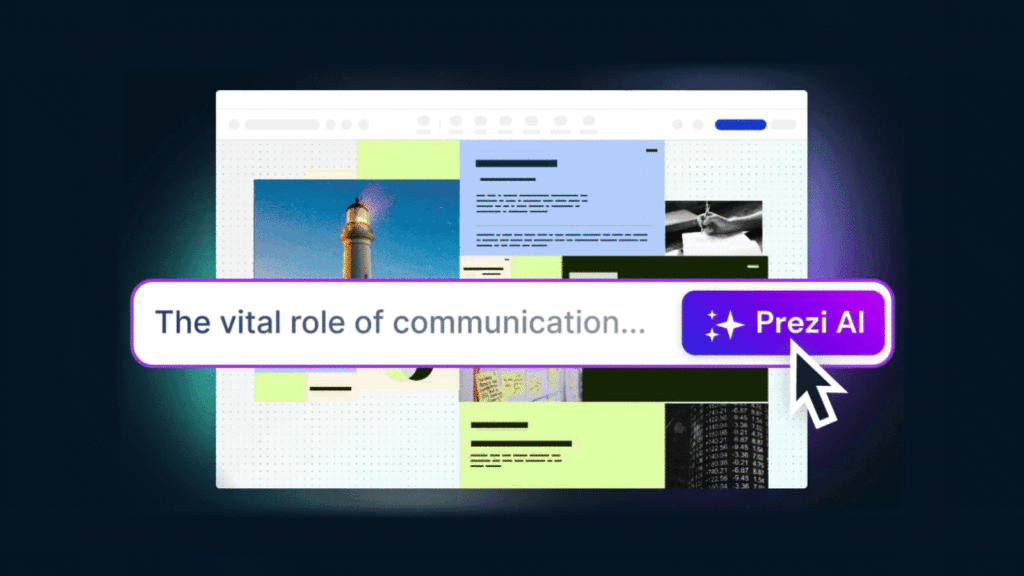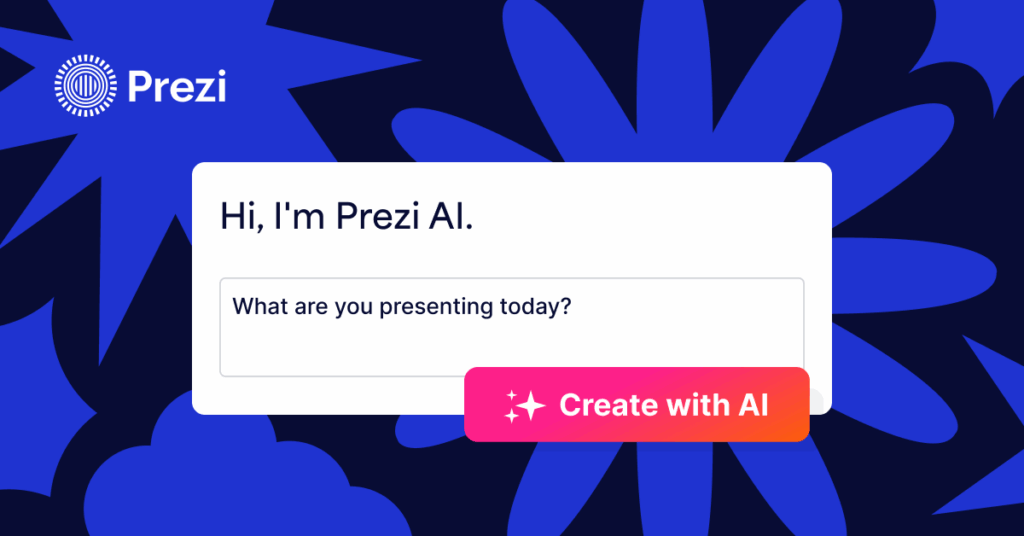Artificial intelligence is transforming every industry, and education is no exception. Today, using AI in the classroom is becoming a powerful way to enhance how we teach, learn, and interact. From improving student engagement to automating administrative tasks, AI classroom tools have the potential to revolutionize traditional learning models.
With tools like Prezi AI, educators and students can create dynamic, personalized presentations faster than ever before. As classrooms become more digital, it’s essential to understand how to use AI in the classroom effectively, responsibly, and ethically.

The rise of AI in the classroom
AI in the classroom goes beyond just robots and high-tech devices; it involves a wide range of AI tools for the classroom that are aimed at supporting educators and learners alike. From personalized learning systems to AI-driven educational games to classroom presentation software, there are many opportunities out there. The increased use of AI resources in schools is reshaping teaching methods and opening new doors to tailored learning journeys.
Personalized learning experiences
One major benefit of using AI in the classroom is the ability to personalize education. AI classroom tools can analyze student performance data and help teachers tailor instruction to individual strengths and challenges. This allows students to learn at their own pace, revisiting foundational topics or accelerating through familiar material. Moreover, this personalized method helps teachers recognize students in need of assistance, leading to interventions that improve overall learning achievements.
In an AI classroom, teachers can create differentiated lesson plans based on student needs, ensuring every learner is challenged and supported.
Automation of administrative tasks
The time teachers spend on tasks such as paper grading, lesson planning, and classroom management is huge. Classroom AI tools can automate these processes, giving educators more time to focus on actual teaching. For example, a system powered by AI can grade assignments and make sure students get immediate and consistent feedback. This quickens the process of grading and helps students quickly figure out their mistakes.
More student engagement
An AI classroom makes learning interactive. AI classroom tools might boost student engagement by having the ability to make learning interactive and fun. Teaching conventionally can fail to capture the interest of all students, especially when dealing with very abstract or complex concepts. Educational games, simulations, and other interactive features powered by AI can breathe life into these concepts, making them more understandable and interesting for learners. For example, AI may generate immersive learning experiences through which learners are capable of going through historical events, scientific phenomena, or mathematical quests in a virtual environment.

Real-time feedback and assessment
Immediate feedback is critical for learning. Using AI in the classroom allows for instant corrections and suggestions, helping students learn from mistakes on the spot.
A problem in conventional education is the time gap between the student doing an assignment and getting the results. AI can provide feedback in real time, so students can be corrected immediately after making an error, streamlining the process. Instant feedback loops are vital for learning because they enable students to rectify mistakes and reinforce their understanding of the content at that particular time. Also, through continuous real-time assessments, teachers can easily keep track of learner progress to detect areas where they might be finding difficulty and offer support when it’s most needed.
Adaptive learning environments
AI in the classroom can develop adaptive learning environments responsive to each learner’s needs. In such environments, the pace and content of learning are modified on the fly according to how students interact with them. For instance, if a learner is doing well in an area, the AI system may present harder material to keep the learner engaged and motivated. On the other hand, if a student is failing, then the system can provide extra resources or even reduce the material so that they understand. This will keep each student challenged and supported.
Data-driven insights for educators
Using AI in the classroom gives teachers access to deep insights about student behavior and performance. These analytics help identify at-risk students, optimize lesson plans, and even uncover which teaching strategies are most effective. Through the analysis of patterns in student performance, it can discover likely events and dispense actionable information to teachers on how they can best go about supporting their students. It may also come to show that specific groups of students are better off with particular teaching aids or that specific students are at-risk learners. With such knowledge, teachers can adjust instruction for greater student success in meeting learner needs.

Streamlined communication and collaboration
AI classroom tools can also improve communication and collaboration. This means using AI-powered platforms to facilitate better communication between teachers or students, and parents to ensure that everyone is well-informed and engaged. For example, AI could automatically send reminders about upcoming assignments, tests, or parent-teacher meetings. In addition, tools based on AI can foster collaborative learning in the sense that learners can work together on projects within virtual environments; here the AI may help by providing resources, monitoring progress, and giving feedback.
Inclusive learning opportunities
One of the most promising aspects of using AI in the classroom is how it fosters inclusivity. The design of AI tools can be tailored to support different styles of learning and different abilities to ensure that all students receive appropriate education. For example, AI may enable students to access content through speech-to-text or text-to-speech tools for those who have impairments relating to sight or hearing. In addition, it provides personalized assistance to learners with special needs who may have disabilities like dyslexia or ADHD, helping them combat challenges and ensuring success.
A classroom AI tool you need: Prezi AI
One of the most impactful AI classroom tools is Prezi—an AI-powered presentation tool that helps educators and students build visually rich, organized presentations quickly. It transforms complex content into engaging, cinematic experiences

Smart structuring: Prezi AI helps users organize their content in a logical and visually appealing way. The AI suggests the best layout based on the type of content, ensuring that information is presented clearly and effectively. This smart structuring helps students and teachers communicate complex ideas more clearly, leading to better understanding and retention.
Time-saving automation: With AI handling many of the design elements, Prezi allows users to focus on the content rather than spending hours on formatting. This time-saving feature means that teachers can quickly create presentations that aren’t just informative but also engaging, allowing more time for interactive classroom activities.
Better engagement: Prezi’s AI-driven features contribute to creating dynamic presentations that capture and hold students’ attention. The AI can recommend visual aids, animations, and transitions that keep the audience engaged, making learning more interactive and enjoyable. This increased engagement can lead to better participation and deeper learning outcomes.
Prezi AI: How to use AI in the classroom
Prezi goes beyond being a classroom presentation software; it represents a significant change in how AI is integrated into the educational setting. By using its AI-powered presentation designer, creating presentations becomes easier than ever before. Take a look at how Prezi AI is one of the best classroom AI tools.
Prezi AI is your personal presentation designer, built to transform your ideas into dynamic presentations that move your audience. It doesn’t rely on rigid templates—instead, it generates unique, engaging presentations customized to your content.
Why educators love Prezi AI:
- Your design partner, instantly: Prezi AI recommends smart layouts, visuals, and transitions tailored to your goals. Whether you’re building a science lecture or a class project, you’ll have an expert designer by your side.
- Create faster, teach better: Under a tight deadline? Prezi AI helps you build stunning presentations in seconds, so you can spend more time focusing on your students.
- Beyond slides: With cinematic zooms, Prezi goes beyond static slides, keeping students engaged and focused on your key points.
- Science-backed results: Presentations made with Prezi are 25% more effective than traditional slides. That means better retention and greater impact.
- Powered by expertise: Our AI model has been trained on over 500 million public presentations and designed by professionals with 15+ years of experience.
Educators can use Prezi AI to simplify complex topics, create interactive lesson materials, and deliver standout presentations that students remember.

Free eBook: The Educator’s Guide to AI in the Classroom
AI is making its way into schools and universities, and many educators are stressing the importance of embracing AI. In June 2024, Prezi surveyed 2,400 educators and revealed that 85% of respondents are likely to integrate AI presentation software into their teaching for the upcoming school year.
While the promise of AI in education is vast, it’s accompanied by valid concerns from educators and parents regarding student data privacy and security. This guidebook addresses these concerns, providing insights and strategies from educators at all levels — K-8, 9-12, and higher
education — and educational consultants. In this ebook, you’ll uncover the practical applications of AI in the classroom and learn how tools like Prezi AI can be effectively utilized by both students and educators.
How to use AI in the classroom
The idea of how to use AI in the classroom may appear overwhelming. But, when done right, it can be seamless and quite beneficial to both teachers and students. Here are some practical tips on how to integrate AI in the classroom:
1. Start with simple AI tools
For those just starting out with AI, you may want to begin with simple tools such as AI-powered quizzes or using interactive learning platforms. These are often very easy to use and require little to no setup, making them ideal for teachers who are just starting to dabble in using AI in the classroom.
2. Incorporate AI into lesson plans
Integration of AI into lesson plans can be done in various ways. For example, using AI tools to ensure appropriate difficulty and backing for the students, and also being able to generate real-time feedback on assignments explicitly with AI. This way, learners can improve their work in less time with more effect.
3. Use AI for classroom management
AI isn’t just for teaching; it could also be helpful in classroom management. AI-powered systems can watch student progress, take attendance, and predict which students need additional help. With such technology at their disposal, teachers can now manage their classrooms more effectively and give help that’s specific to their students.

Important considerations for educators and students
The benefits of AI in the classroom are clear from the above arguments; however, it’s important how it’s put into practice. Teachers should use AI to help them with their traditional teaching methods instead of replacing them. Also, the protection of data privacy and security should be given importance by educators. A lot of AI platforms analyze student data to provide personalized learning for each child.
Furthermore, students should use AI as a facilitator of their learning and not an immediate solution. Even though artificial intelligence can help out, students need to keep sharpening their thinking and analytic abilities. Educators have a part in training students how to use AI in the classroom: leading them to reap its benefits and not fall into complete reliance.
When it comes to the ethical use of AI in the classroom, educators must prioritize student privacy and ensure transparency when using AI. AI tools often process sensitive data, so selecting platforms with robust security measures is essential.
Teach students to use AI responsibly, emphasizing critical thinking and ethical usage.
The future of AI in the classroom
The future of AI in the classroom is sure to be very bright. As tech keeps moving, so do the strategies that can be used to bring AI to our classrooms. From personalized learning experiences to cutting-edge teaching tools, an AI classroom is bound to revolutionize education in ways far beyond our imagination.
By embracing AI in the classroom, educators can provide students with the tools they need to succeed in an increasingly digital world. And with platforms like Prezi leading the way, creating engaging and informative lessons has never been easier.
All in all, integrating AI in the classroom offers immense potential to improve learning outcomes and classroom management, and engage students in new and exciting ways. By using tools like Prezi AI, educators can leverage the power of AI to create dynamic and personalized learning experiences that prepare students for the future. As we move forward, the key will be to balance AI with traditional teaching methods, ensuring that technology enhances, rather than replaces, the human elements of education. Start using AI in your classroom today, and help your students thrive in a digital world.
